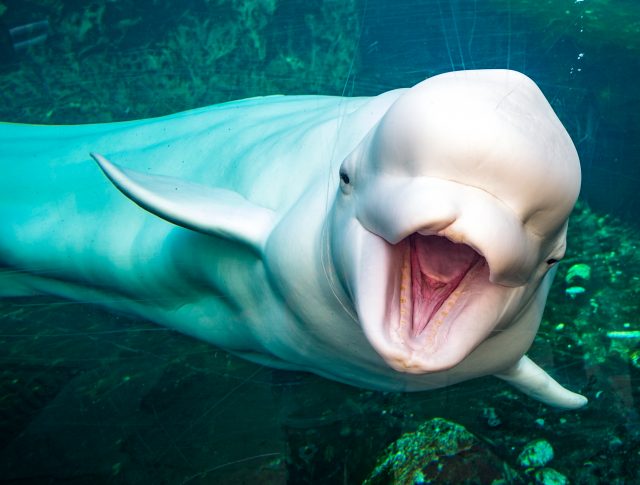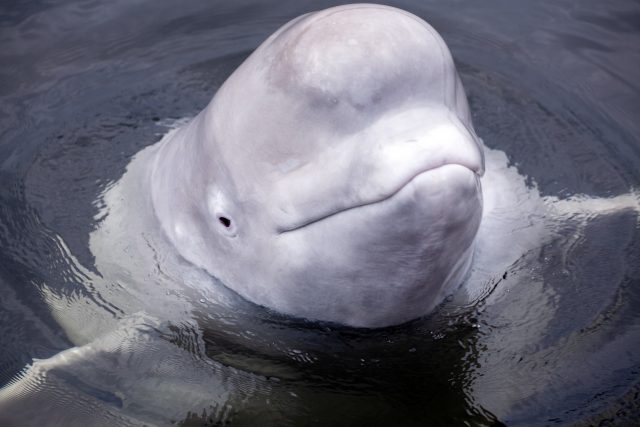6 Jaw-Dropping Facts About Beluga Whales
Easy to recognize, always smiling and white like a snowflake – beluga whales are definitely one of a kind! These famous sea dwellers are everybody’s darling, and we won’t blame anyone as they are purely fascinating creatures.
Beluga whales, also called white whales, live throughout the Arctic Ocean and call the waters around Alaska, Russia, Canada, and Greenland home. These mammals are one of the smallest whale species – but don’t let that fool you as they can still reach a weight of up to 1,600 kg (3,530 lb)! On top of that, they’re highly social animals and spend most of their life mingling with their pods.
Keen to learn more about our unique little friends? Check out our fun facts about beluga whales for your daily dose of knowledge!

1. Slow but steady swimmers
We obviously knew that beluga whales live in the sea, yet we are still surprised by their incredible swimming skills! They might not be the fastest underwater – okay, let’s face it, they are actually pretty slow and travel with a maximum speed of 22 km/h (14 mph), which is half the speed of orca whales.
But slow and steady wins the race! Beluga whales cover massive distances when migrating southward in large pods during summer. Every year around July and August, more than 50,000 beluga whales migrate thousands of kilometres into Canada's Hudson Bay to feed, give birth, and enjoy the (relatively) warm waters.
But that’s not all: Belugas can dive underwater for up to 25 minutes and can reach impressive depths of 800 meters! And they have a solid backstroke and can glide through the Arctic waters on their back, just like dolphins do.
2. Melonhead meets canary of the sea
How are melon heads and echolocation connected? More than you might think! Beluga whales, often referred to as ‘canaries of the sea’, owe their impressive echolocation skills to the remarkable shape of their heads. They are known to be one of the most vocal whale species and communicate and find their bearings with a broad repertoire of whistles, clicks, mews, bleats, and chirps.
Echolocation, the process in which animals use echoes of their calls to locate and identify objects, is aided by the beluga whale’s bulbous forehead structure. The fatty organ changes shape during the whale’s vocalization, as air moves between the nasal sacs and finally produces sounds. Nature strikes again!
3. Mummy’s darling aka beluga calves
Having babies is quite a long-term commitment for beluga whales! Not only do they carry their little ones significantly longer than humans do (14 months to be specific), but the calves are also nursing from their moms for up to two years.
Considering this lengthy pregnancy and the heavy reliance of the calf on its mother, it does make sense that female belugas only reproduce about every three years.
4. How-to-survive-in-the-Arctic starter kit
You probably already got the idea – beluga whales are extremely unique animals! Especially their appearance is highly unusual and like no other.
Did you know for instance that belugas are born dark grey and only turn white after up to eight years? Nevertheless, the name ‘beluga’ comes from the Russian word ‘bielo’, which means white.
Unlike other whales, our Arctic friend does not have dorsal fins, which is an adaption to its icy habitat, as an extra fin would result in extra heat loss. Instead, beluga whales have a tough dorsal ridge and a thick layer of insulating blubber to protect them from the relentless cold.
On top of that, these friendly mammals have the special ability to turn their heads up, down, and side-to-side. This is thanks to the fact that a beluga’s neck is not fused together and it’s a useful adaptation to target its prey in areas full of ice.
In short, a beluga whale is definitely one of Mother Nature’s best works!
5. Eating and being eaten
Do you know what belugas enjoy for lunch? The answer is seafood! A beluga whale is not a picky eater and feeds on a wide range of fish, squids, crustaceans, and worms. And they’re not having exactly little serves of these either! The carnivores eat a whopping 27 kilograms (60 lbs) of food per day.
Despite being a toothed whale, these greedy pigs swallow their prey as a whole. That might sound intimidating; however, beluga whales are not at the top of the food chain. Throughout the Arctic range, polar bears and killer whales are known predators of our adorable melonheads.
6. A not so funny fun fact
Not only do beluga whales need to keep a close eye on their predators, but they are also facing a range of other gloomy threats. These include climate change, the oil and gas development in the Arctic, hunting, and industrial and urban pollution. On top of that, beluga whales are the aquatic mammal that is kept in captivity the most!
All these threats are human-induced and jeopardize the natural habitat and conservation of the beluga whale. In fact, belugas are currently classified as ‘near threatened’ on the IUCN red list with a remaining population of 150,000 individuals.

How’s that for today’s dose of marine knowledge? If all these fascinating facts have inspired you to explore the Arctic yourself, you should definitely check out the cruises we offer to the Arctic region.
Feel free to contact our team which is always happy to help out with any questions.
Where Will You Go Next ?
- Popular Destinations
- Antarctica
- The Arctic
- South America
- Central America
- More to explore
- Amazon
- Antarctic Circle
- Antarctic Peninsula
- Argentina
- Bolivia
- Brazil
- Canadian Arctic
- Chile
- Colombia
- Costa Rica & Panama
- East Antarctica
- Ecuador
- Galapagos Islands
- Greenland
- Guatemala & Honduras
- Machu Picchu
- Mexico
- Patagonia
- Peru
- South Georgia and Falkland Islands
- Spitsbergen
- Sub Antarctic Islands

Talk to one of our experienced Destination Specialists to turn your Antarctic, Arctic and South American dream into a reality.
Contact us